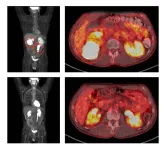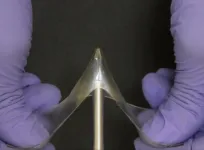(Press-News.org) Adults with a history of low back pain went nearly twice as long without a recurrence of their back pain if they walked regularly, a world-first study has found.
About 800 million people worldwide have low back pain, and it is a leading cause of disability and reduced quality of life.
Repeated episodes of low back pain are also very common, with seven in 10 people who recover from an episode going on to have a recurrence within a year.
Current best practice for back pain management and prevention suggests the combination of exercise and education. However, some forms of exercise are not accessible or affordable to many people due to their high cost, complexity, and need for supervision.
A clinical trial by Macquarie University’s Spinal Pain Research Group has looked at whether walking could be an effective, cost-effective and accessible intervention.
The trial followed 701 adults who had recently recovered from an episode of low back pain, randomly allocating participants to either an individualised walking program and six physiotherapist-guided education sessions over six months, or to a control group.
Researchers followed the participants for between one and three years, depending on when they joined, and the results have now been published in the latest edition of The Lancet.
The paper’s senior author, Macquarie University Professor of Physiotherapy, Mark Hancock, says the findings could have a profound impact on how low back pain is managed.
“The intervention group had fewer occurrences of activity limiting pain compared to the control group, and a longer average period before they had a recurrence, with a median of 208 days compared to 112 days,” Professor Hancock says.
“Walking is a low-cost, widely accessible and simple exercise that almost anyone can engage in, regardless of geographic location, age or socio-economic status.
“We don’t know exactly why walking is so good for preventing back pain, but it is likely to include the combination of the gentle oscillatory movements, loading and strengthening the spinal structures and muscles, relaxation and stress relief, and release of ‘feel-good’ endorphins.
"And of course, we also know that walking comes with many other health benefits, including cardiovascular health, bone density, healthy weight, and improved mental health.”
Lead author Dr Natasha Pocovi says in addition to providing participants with longer pain-free periods, the program was very cost-effective.
“It not only improved people’s quality of life, but it reduced their need both to seek healthcare support and the amount of time taken off work by approximately half,” she says.
“The exercise-based interventions to prevent back pain that have been explored previously are typically group-based and need close clinical supervision and expensive equipment, so they are much less accessible to the majority of patients.
“Our study has shown that this effective and accessible means of exercise has the potential to be successfully implemented at a much larger scale than other forms of exercise.”
To build on these findings, the team now hopes to explore how they can integrate the preventive approach into the routine care of patients who experience recurrent low back pain.
The paper will be available here after publication: https://www.thelancet.com/journals/lancet/article/PIIS0140-6736(24)00755-4/fulltext
END
Walking brings huge benefits for low back pain, study finds
2024-06-20
ELSE PRESS RELEASES FROM THIS DATE:
Study finds one copy of protective genetic variant helps stave off early-onset Alzheimer’s disease
2024-06-19
KEY TAKEAWAYS
An international team, including researchers from Mass General Brigham, has been searching for protective genetic variants in a family that includes more than 1,000 individuals who are genetically predisposed to develop early onset Alzheimer’s disease in their 40s.
Previously, the researchers identified the “Christchurch variant” as potentially protective against Alzheimer’s based on one family member who had two copies of this variant and was expected to develop dementia in her ...
Combination targeted treatment produces lasting remissions in people with resistant aggressive B-cell lymphoma
2024-06-19
Embargoed for Release
Wednesday, June 19, 2024
5:00 p.m. ET Contact: NCI Press Office
240-760-6600
NCIPressOfficers@nih.gov
NOTE: A virtual briefing is scheduled for Tuesday, June 18, 2024, at 1:00 p.m. ET. Details below.
Researchers at the National Institutes of Health (NIH) have developed a non-chemotherapy treatment regimen that is achieving full remissions for some people with aggressive B-cell lymphoma that has come back or is no longer responding to standard treatments. The five-drug combination targets multiple molecular pathways that diffuse large B-cell lymphoma (DLBCL) tumors use to survive.
In ...
Common prostate drugs tied to lower risk of dementia with lewy bodies
2024-06-19
EMBARGOED FOR RELEASE UNTIL 4 P.M. ET, WEDNESDAY, JUNE 19, 2024
MINNEAPOLIS – Certain drugs used to treat urinary symptoms due to an enlarged prostate may be associated with a reduced risk of dementia with Lewy bodies, according to a study published in the June 19, 2024, online issue of Neurology®, the medical journal of the American Academy of Neurology. Dementia with Lewy bodies is a progressive neurodegenerative disorder that can cause memory and thinking issues, movement problems and issues such as hallucinations.
The results do not prove that these drugs reduce the risk of dementia ...
Drugs for enlarged prostate may also protect against dementia with Lewy bodies
2024-06-19
A new study suggests that certain drugs commonly used to treat enlarged prostate may also decrease the risk for dementia with Lewy bodies (DLB). This observational finding may seem surprising, but it mirrors previous work by the University of Iowa Health Care team that links the drugs to a protective effect in another neurodegenerative condition–Parkinson's disease.
The UI researchers think that a specific side effect of the drugs targets a biological flaw shared by DLB and Parkinson’s disease, as well as other neurodegenerative ...
Titan’s lakes may be shaped by waves
2024-06-19
Titan, Saturn’s largest moon, is the only other planetary body in the solar system that currently hosts active rivers, lakes, and seas. These otherworldly river systems are thought to be filled with liquid methane and ethane that flows into wide lakes and seas, some as large as the Great Lakes on Earth.
The existence of Titan’s large seas and smaller lakes was confirmed in 2007, with images taken by NASA’s Cassini spacecraft. Since then, scientists have pored over those and other images for clues to the moon’s mysterious ...
YALE EMBARGOED NEWS: Family psychiatric history: Effects on siblings of children with autism
2024-06-19
New Haven, Conn. — Children who have an older sibling with autism spectrum disorder (autism) are at greater risk of developmental vulnerabilities if they also have other relatives with neurodevelopmental or psychiatric conditions, according to a new study from the Yale Child Study Center.
Researchers found that the siblings of children with autism had an increase in the severity of social and communication difficulties — which are common in autism — if they had relatives with conditions such as schizophrenia or anxiety. Family histories of anxiety and intellectual disability were also associated ...
New technology provides electrifying insights into how catalysts work at the atomic level
2024-06-19
A team led by Lawrence Berkeley National Laboratory (Berkeley Lab) has invented a technique to study electrochemical processes at the atomic level with unprecedented resolution and used it to gain new insights into a popular catalyst material. Electrochemical reactions – chemical transformations that are caused by or accompanied by the flow of electric currents – are the basis of batteries, fuel cells, electrolysis, and solar-powered fuel generation, among other technologies. They also drive biological processes such as photosynthesis ...
Researchers create new class of materials called ‘glassy gels’
2024-06-19
Researchers have created a new class of materials called “glassy gels” that are very hard and difficult to break despite containing more than 50% liquid. Coupled with the fact that glassy gels are simple to produce, the material holds promise for a variety of applications.
Gels and glassy polymers are classes of materials that have historically been viewed as distinct from one another. Glassy polymers are hard, stiff and often brittle. They’re used to make things like water bottles or airplane windows. Gels – such as contact lenses – contain liquid and are soft and stretchy.
“We’ve created a class of materials ...
Tabulae Paralytica: Mapping the biology of spinal cord injury in unprecedented detail
2024-06-19
Scientists at EPFL have achieved a significant research milestone in the field of spinal cord injuries—mapping out the cellular and molecular dynamics of paralysis in unprecedented detail with their open-source project 'Tabulae Paralytica'. Grégoire Courtine and his team have integrated cutting-edge cell and molecular mapping technologies with artificial intelligence to chart the complex molecular processes that unfold in each cell after spinal cord injuries (SCI). Published in Nature, this seminal ...
When in drought: Researchers map which parts of the Amazon are most vulnerable to climate change
2024-06-19
In the late 2000s, Scott Saleska noticed something strange going on in the Amazon rainforest.
In 2005, a massive drought struck the region. Two years later, Saleska – a University of Arizona professor in the Department of Ecology and Evolutionary Biology – published surprising research that used satellite images to find that the drought resulted in more green growth in large swaths of the Amazon. On the other hand, field researchers saw plants brown and some die in response to the drought.
Research published today in the journal Nature reveals what caused the scientific mismatch. Shuli Chen, a doctoral degree candidate in ecology and evolutionary ...






